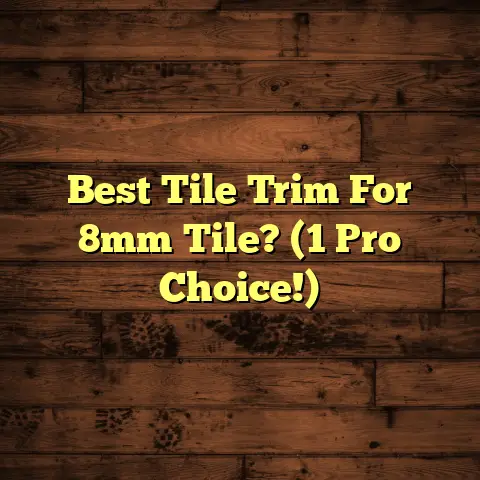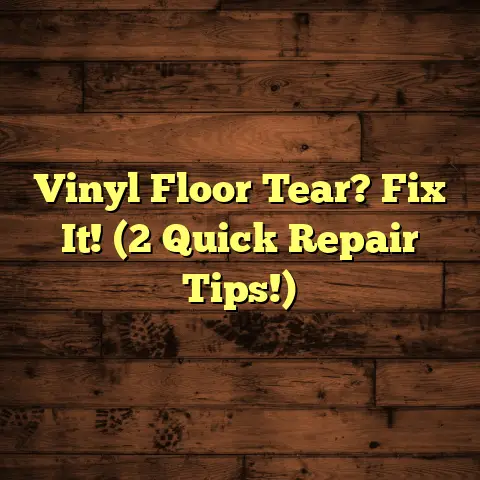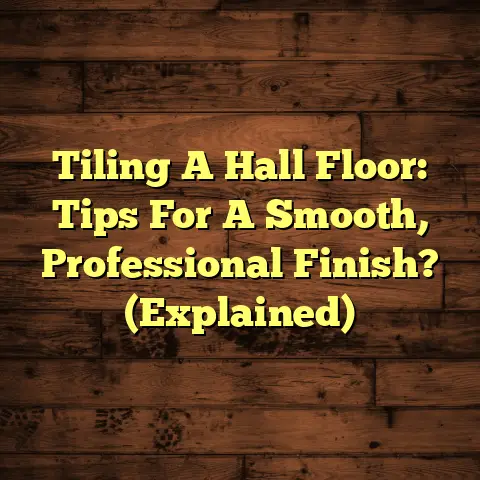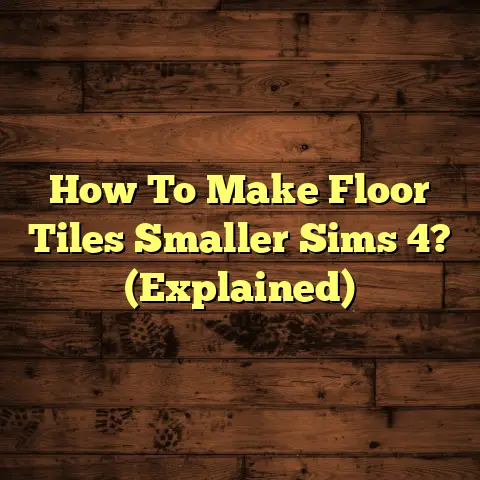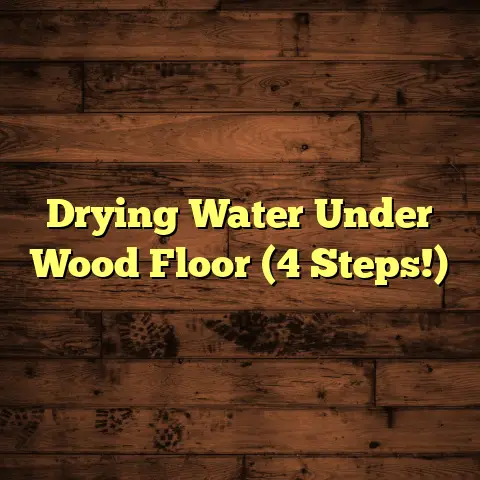Clean Hardwood With Vinegar? (5 Tips You NEED!)
Think about it: When you walk into a house with gleaming hardwood, what’s your first impression? Probably something like “quality” and “well-maintained,” right?
That’s exactly what potential buyers think too!
A study by the National Association of Realtors (NAR) showed that 54% of buyers are willing to pay more for a home with hardwood floors.
I have personally seen homes with beat-up carpets sit on the market for months, while similar homes with pristine hardwood get snatched up in days.
So, keeping those hardwoods in tip-top shape isn’t just about aesthetics; it’s about protecting your investment!
Now, one of the most common questions I get is, “Can I clean my hardwood with vinegar?”
The answer is yes, but with a few very important caveats. Vinegar is a fantastic, natural cleaner, but it can also damage your floors if you’re not careful.
That’s why I’m going to share my top 5 tips for safely and effectively cleaning your hardwood floors with vinegar. Ready to dive in?
Tip 1: Understand the Right Dilution Ratio
Okay, let’s talk about the science of vinegar! Vinegar is essentially acetic acid, and that acid is what gives it its cleaning power.
It’s great at cutting through grease and grime. However, that acid can also be tough on your hardwood floor’s finish if you’re not careful.
Think of it like this: You wouldn’t use pure bleach to clean your countertops, would you? Same principle applies here.
Using undiluted vinegar can dull or even strip the finish over time, leaving your floors looking sad and worn.
So, what’s the magic ratio? I always recommend 1 part vinegar to 10 parts water.
This creates a gentle solution that’s effective at cleaning without being too harsh.
I’ve seen homeowners go wrong by thinking “more vinegar = cleaner floors”. Trust me, it doesn’t work that way!
Stick to the 1:10 ratio. It’s the sweet spot!
Tip 2: Test in an Inconspicuous Area
Alright, before you go sloshing vinegar solution all over your beautiful floors, let’s do a little test.
This is like a skin allergy test before using a new lotion. You want to make sure your floors aren’t going to react negatively.
Find an inconspicuous area, like inside a closet, under a rug, or in a corner that’s usually hidden.
Apply a small amount of your vinegar solution to that area and let it sit for a few minutes.
Then, wipe it up with a clean cloth.
Now, wait 24 hours and check for any adverse reactions.
What are you looking for? * Dulling of the finish: Does the tested area look less shiny than the surrounding floor? * Discoloration: Has the color changed at all? * Stickiness: Does the area feel tacky or sticky to the touch?
If you see any of these signs, stop right there! Vinegar might not be the right cleaner for your floors.
You might need to consider a specialized hardwood floor cleaner instead.
I once had a client who skipped this step and ended up with a cloudy patch in the middle of their living room.
Trust me, a little testing now can save you a lot of heartache (and money!) later.
Tip 3: Use the Right Tools for Application
Okay, you’ve got your diluted vinegar solution ready, and you’ve done your test patch. Now, let’s talk tools.
The key here is to use something soft and non-abrasive. I’m a big fan of microfiber mops and cloths for hardwood floors.
Why microfiber? Well, the tiny fibers are super absorbent and gentle on the surface. They pick up dirt and grime without scratching the finish.
Avoid using traditional string mops. They tend to hold a lot of water, which we want to avoid (more on that in a bit), and they can sometimes leave streaks.
Also, steer clear of anything with a rough or abrasive surface, like scrub brushes or scouring pads. Those are a big no-no for hardwood!
When you’re mopping, make sure your mop head is damp, not soaking wet.
Wring it out really well before you start. You want to apply the solution evenly and lightly.
I like to use a spray bottle to mist the floor lightly, then follow up with the microfiber mop.
This gives me more control over the amount of liquid I’m using.
Remember, we’re going for a gentle cleaning, not a flood!
Tip 4: Avoid Over-Wetting the Floor
This is HUGE. Seriously, this is probably the most common mistake I see homeowners make when cleaning hardwood floors.
Water is the enemy of hardwood. When water seeps into the seams and cracks, it can cause the wood to warp, swell, and even rot over time.
I’ve had to repair floors where excessive moisture caused bubbling and the planks to separate. It’s not pretty, and it’s not cheap to fix!
So, how do you avoid over-wetting?
- Wring, wring, wring! I can’t stress this enough. Make sure your mop or cloth is thoroughly wrung out before you start cleaning. It should be damp to the touch, not dripping wet.
- Work in small sections: Don’t try to clean the entire floor at once. Focus on small areas, like a 4×4 foot section, and clean that before moving on.
- Dry as you go: If you notice any puddles or excess moisture, wipe them up immediately with a clean, dry cloth.
I always tell my clients to think of it like this: You’re not washing the floor; you’re wiping it clean.
A light touch is key!
Tip 5: Follow Up with Proper Drying Techniques
Okay, you’ve cleaned your floors with your diluted vinegar solution, you’ve avoided over-wetting, and now it’s time for the final step: drying.
Proper drying is just as important as the cleaning itself. You want to make sure all the moisture is gone to prevent any potential damage.
Here are a few drying techniques I recommend:
- Air drying: This is the simplest method. Just open some windows and let the air circulate. The natural airflow will help the floors dry quickly.
- Using fans: If you want to speed things up, you can use fans to circulate the air. Place a fan or two in the room and point them towards the floor.
- Towel drying: For a super thorough drying, you can use a soft, dry towel to wipe up any remaining moisture. This is especially helpful in areas that tend to hold water, like corners and edges.
How do you know when your floors are completely dry? The best way is to simply touch them.
They should feel cool and dry to the touch. If they feel damp or sticky, give them a little more time to dry.
I usually give my floors at least 30 minutes to an hour to dry completely.
Patience is key here! Don’t rush the process, or you could end up with moisture problems down the road.
Conclusion: The Benefits of Vinegar Cleaning for Hardwood Floors
So, there you have it! My top 5 tips for cleaning hardwood floors with vinegar.
By following these guidelines, you can keep your floors looking beautiful and protect your investment.
Vinegar is a fantastic, natural cleaner that’s safe and effective when used properly.
Just remember:
- Dilute, dilute, dilute!
- Test before you commit.
- Use the right tools.
- Avoid over-wetting.
- Dry thoroughly.
I’ve seen firsthand how much of a difference well-maintained hardwood floors can make in a home’s value.
It’s not just about aesthetics; it’s about creating a welcoming and inviting space that buyers will fall in love with.
And when it comes time to sell, those gleaming hardwood floors will be a major selling point that can help you get top dollar for your home.
So, go ahead and give your hardwood floors a little TLC with vinegar. Your floors (and your wallet!) will thank you for it.
Happy cleaning!
